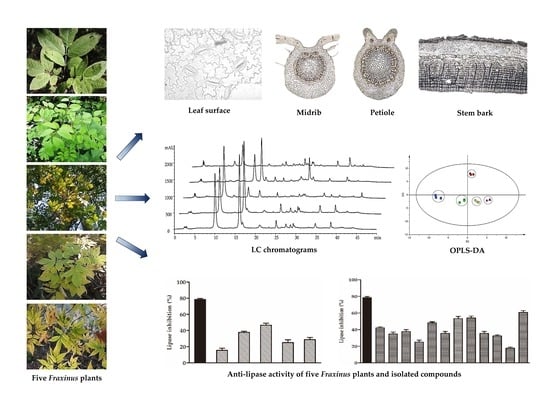Comparative Studies of Fraxinus Species from Korea Using Microscopic Characterization, Phytochemical Analysis, and Anti-Lipase Enzyme Activity
Abstract
1. Introduction
2. Results
2.1. Anatomical Characteristics of the Leaf
2.2. Anatomical Characteristics of the Petiole
2.3. Anatomical Characteristics of the Midrib
2.4. Anatomical Characteristics of the Stem Bark
2.5. HPLC-DAD Profiles of Five Fraxinus Plants
2.6. Orthogonal Projections to Latent Structures-Discriminant Analysis (OPLS-DA) Multivariate Statistical Analysis
2.7. Anti-lipase Activity
3. Discussion
4. Materials and Methods
4.1. Chemicals and Reagents
4.2. Plant Materials
4.3. Anatomical Analysis
4.4. Sample Preparation
4.5. HPLC-DAD Analysis
4.6. Pancreatic Lipase Inhibition Assay
4.7. Statistical Analysis
5. Conclusions
Supplementary Materials
Author Contributions
Funding
Conflicts of Interest
References
- Wallander, E. Systematics of Fraxinus (Oleaceae) and evolution of dioec. Plant. Syst. Evol. 2007, 273, 25–49. [Google Scholar] [CrossRef]
- Kim, S.C.; Baek, S.H.; Lee, M.W.; Nak, K. The complete chloroplast genome of Fraxinus chiisanensis (Oleaceae). Mitochondrial DNA B 2017, 2, 823–824. [Google Scholar] [CrossRef]
- Hinsinger, D.D.; Basak, J.; Gaudeul, M.; Cruaud, C.; Bertolino, P.; Frascaria-Lacoste, N.; Bousquet, J. The phylogeny and biogeographic history of ashes (Fraxinus, Oleaceae) highlight the roles of migration and vicariance in the diversification of temperate trees. PLoS ONE 2013, 8, e80431. [Google Scholar] [CrossRef]
- MacFarlane, D.W.; Meyer, S.P. Characteristics and distribution of potential ash tree hosts for emerald ash borer. Forest Ecol. Manag. 2005, 213, 15–24. [Google Scholar] [CrossRef]
- Wallander, E.; Albert, V.A. Phylogeny and classification of Oleaceae based on rps16 and trnL-F sequence data. Am. J. Bot. 2000, 1827–1841. [Google Scholar] [CrossRef]
- Kim, C. The distribution of the woody plants of South Korea based on herbarium (SNUA) material of The arboretum (VII)—Rhamnaceae. Bull. Seoul Natl. Univ. Arbor. 2001, 21, 1–15. [Google Scholar]
- Calis, I.; Hosny, M.; Khalifa, T.; Nishibe, S. Secoiridoids from Fraxinus angustifolia. Phytochemistry 1993, 33, 1453–1456. [Google Scholar] [CrossRef]
- Kim, H.C.; An, R.B.; Jeong, G.S.; Oh, S.H. 1,1-diphenyl-1-picrylhydrazyl radical scavenging compounds from Cortex Fraxini. Nat. Prod. Sci. 2005, 11, 150–154. [Google Scholar]
- Guo, S.; Guo, T.; Cheng, N.; Liu, Q.; Zhang, Y.; Bai, L.; Zhang, L.; Cao, W.; Ho, C.T.; Bai, N. Hepatoprotective standardized EtOH-water extract from the seeds of Fraxinus rhynchophylla Hance. J. Tradit. Complement. Med. 2017, 7, 158–164. [Google Scholar] [CrossRef][Green Version]
- Chen, Y.; Xue, G.; Liu, F.; Gong, X. Immunosuppressive effect of extracts from leaves of Fraxinus mandshurica Rupr. Bioengineered 2017, 8, 212–216. [Google Scholar] [CrossRef]
- Hiroki, T.; Sueo, H.; Sansei, N. Coumarins from bark of Fraxinus japonica and F. mandshurica var. japonica. Chem. Pharm. Bull 1985, 33, 4069–4073. [Google Scholar]
- Kostova, I.; Iossifova, T. Chemical components of Fraxinus species. Fitoterapia 2007, 78, 85–106. [Google Scholar] [CrossRef]
- Sarfraz, I.; Rasul, A.; Jabeen, F.; Younis, T.; Zahoor, M.K.; Arshad, M.; Ali, M. Fraxinus: A plant with versatile pharmacological and biological activities. Evid. Based Complementary Altern. Med. 2017, 2017, 4269868. [Google Scholar] [CrossRef]
- Vandal, J.; Abou-Zaid, M.M.; Ferroni, G.; Leduc, L.G. Antimicrobial activity of natural products from the flora of Northern Ontario, Canada. Pharma. Biol. 2015, 53, 800–806. [Google Scholar] [CrossRef] [PubMed]
- Martin, J.W.; Simon, M. British Herbal Pharmacopoeia, 4th ed.; British Herbal Medicine Association press: Dorset, UK, 1996; p. 212. [Google Scholar]
- Upton, R.; Graff, A.; Jolliffe, G.; Langer, R.; Williamson, W. American Herbal Pharmacopoeia: Botanical Pharmacognosy—Microscopic Characterization of Botanical Medicines, 1st ed.; CRC Press: Boca Raton, FL, USA, 2011; p. 800. [Google Scholar]
- State Pharmacopoeia Commission of the PRC. Pharmacopoeia of the People’s Republic of China, Part I, 10th ed.; China Medical Science Press: Beijing, China, 2015; p. 271. [Google Scholar]
- The Ministry of Health, Labour and Welfare. Japanese Pharmacopoeia (English Version), 17th ed.; The Stationery Office: Tokyo, Japan, 2016; p. 134.
- Obradovic, M.; Krajsek, S.S.; Dermastia, M.; Kreft, S. A new method for the authentication of plant samples by analyzing fingerprint chromatograms. Phytochem. Anal. 2007, 18, 123–132. [Google Scholar] [CrossRef]
- Kothavade, R.J.; Dhurat, R.S.; Mishra, S.N.; Kothavade, U.R. Clinical and laboratory aspects of the diagnosis and management of cutaneous and subcutaneous infections caused by rapidly growing mycobacteria. Eur. J. Clin. Microbiol. Infect. Dis. 2013, 32, 161–188. [Google Scholar] [CrossRef] [PubMed]
- Ahn, J.H.; Shin, E.; Liu, Q.; Kim, S.B.; Choi, K.M.; Yoo, H.S.; Hwang, B.Y.; Lee, M.K. Secoiridoids from the stem barks of Fraxinus rhynchophylla with pancreatic lipase inhibitory activity. Nat. Prod. Res. 2013, 27, 1132–1135. [Google Scholar] [CrossRef] [PubMed]
- Ahn, J.H.; Shin, E.; Liu, Q.; Kim, S.B.; Choi, K.M.; Yoo, H.S.; Hwang, B.Y.; Lee, M.K. Lignan Derivatives from Fraxinus rhynchophylla and inhibitory activity on pancreatic lipase. Nat. Prod. Sci. 2012, 18, 116–120. [Google Scholar]
- Lunagariya, N.A.; Patel, N.K.; Jagtap, S.C.; Bhutani, K.K. Inhibitors of pancreatic lipase: State of the art and clinical perspectives. EXCLI J. 2014, 13, 897–921. [Google Scholar]
- Kim, G.N.; Shin, M.R.; Shin, S.H.; Lee, A.R.; Lee, J.Y.; Seo, B.I.; Kim, M.Y.; Kim, T.H.; Noh, J.S.; Rhee, M.H. Study of antiobesity effect through inhibition of pancreatic lipase activity of diospyros kaki Fruit and Citrus unshiu peel. Biomed Res. Int. 2016, 2016, 1723042. [Google Scholar] [CrossRef]
- De la Garza, A.L.; Milagro, F.I.; Boque, N.; Campion, J.; Martinez, J.A. Natural inhibitors of pancreatic lipase as new players in obesity treatment. Planta Med. 2011, 77, 773–785. [Google Scholar] [CrossRef] [PubMed]
- Akter, K.-M.; Kim, H.-J.; Park, W.S.; Khalil, A.A.K.; Ahn, M.-J. Anti-Helicobacter pylori activity of compounds isolated from Fraxinus mandshurica bark. Nat. Prod. Sci. 2020, in press. [Google Scholar]
- Smillie, T.J.; Khan, I.A. A comprehensive approach to identifying and authenticating botanical products. Clin. Pharmacol. Ther. 2010, 87, 175–186. [Google Scholar] [CrossRef] [PubMed]
- Lee, H.S.; Chang, C.-S.; Kim, H.; Choi, D.Y. A preliminary population genetic study of an overlooked endemic ash, Fraxinus chiisanensis in Korea using allozyme variation. J. Korean For. Soc. 2011, 98, 531–538. [Google Scholar]
- Kim, Y.-S.; Kim, H.; Son, S.-W. The IUCN Red List of Threatened Species. 2016. [Google Scholar] [CrossRef]
- Min, W.K.; Jeon, J.I.; Chang, C.S. A taxonomic reconsideration of Fraxinus chiisanensis (Oleaceae) in South Korea. J. Korean For. Soc. 2001, 90, 266–276. [Google Scholar]
- Kang, J.G.; Park, C.Y. Anti-obesity drugs: A review about their effects and safety. Diabetes Metab. J. 2012, 36, 13–25. [Google Scholar] [CrossRef]
- Glazer, G. Long-term pharmacotherapy of obesity 2000: A review of efficacy and safety. Arch. Intern. Med. 2001, 161, 1814–1824. [Google Scholar] [CrossRef]
- Christensen, R.; Kristensen, P.K.; Bartels, E.M.; Bliddal, H.; Astrup, A. Efficacy and safety of the weight-loss drug rimonabant: A meta-analysis of randomised trials. Lancet 2007, 370, 1706–1713. [Google Scholar] [CrossRef]
- Buchholz, T.; Melzig, M.F. Polyphenolic compounds as pancreatic lipase inhibitors. Planta Med. 2015, 81, 771–783. [Google Scholar] [CrossRef]
- Kuem, N.; Song, S.J.; Yu, R.; Yun, J.W.; Park, T. Oleuropein attenuates visceral adiposity in high-fat diet-induced obese mice through the modulation of WNT10b- and galanin-mediated signalings. Mol. Nutr. Food Res. 2014, 58, 2166–2176. [Google Scholar] [CrossRef]
- Karkovic Markovic, A.; Toric, J.; Barbaric, M.; Jakobusic Brala, C. Hydroxytyrosol, tyrosol and derivatives and their potential effects on human health. Molecules 2019, 24, 2001. [Google Scholar] [CrossRef] [PubMed]
- Jo, T.H.; Kim, S.B.; Ahn, J.H.; Liu, Q.; Hwang, B.Y.; Lee, M.K. Inhibitory activity of benzophenones from Anemarrhena asphodeloides on pancreatic lipase. Nat. Prod. Commun. 2013, 8, 481–483. [Google Scholar] [CrossRef] [PubMed]
- Beladjila, K.A.; Berrehal, D.; De Tommasi, N.; Granchi, C.; Bononi, G.; Braca, A.; De Leo, M. New phenylethanoid glycosides from Cistanche phelypaea and their activity as inhibitors of monoacylglycerol lipase (MAGL). Planta Med. 2018, 84, 710–715. [Google Scholar] [CrossRef] [PubMed]
- Kim, Y.S.; Lee, Y.M.; Kim, H.; Kim, J.; Jang, D.S.; Kim, J.H.; Kim, J.S. Anti-obesity effect of Morus bombycis root extract: Anti-lipase activity and lipolytic effect. J. Ethnopharmacol. 2010, 130, 621–624. [Google Scholar] [CrossRef]
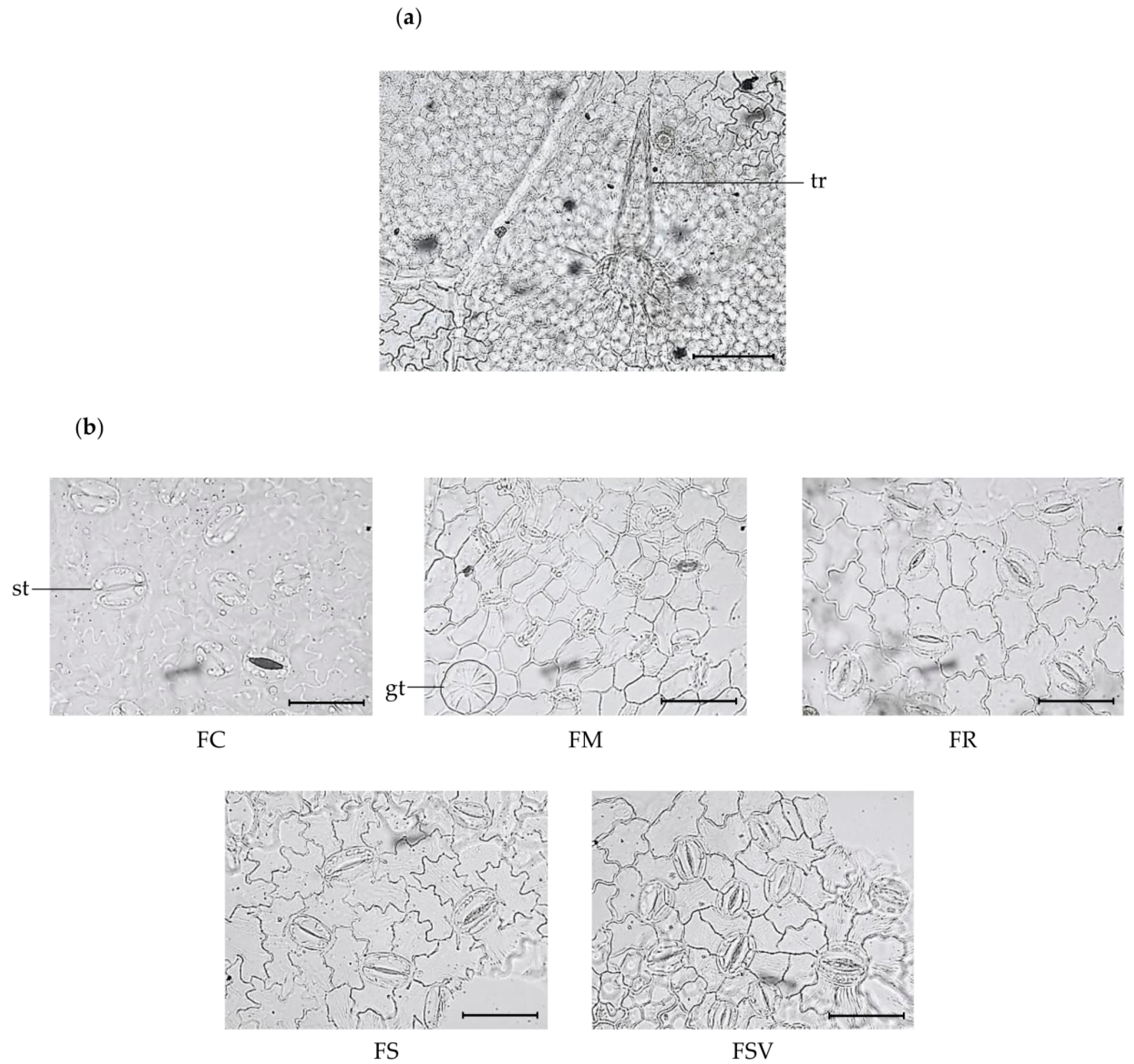
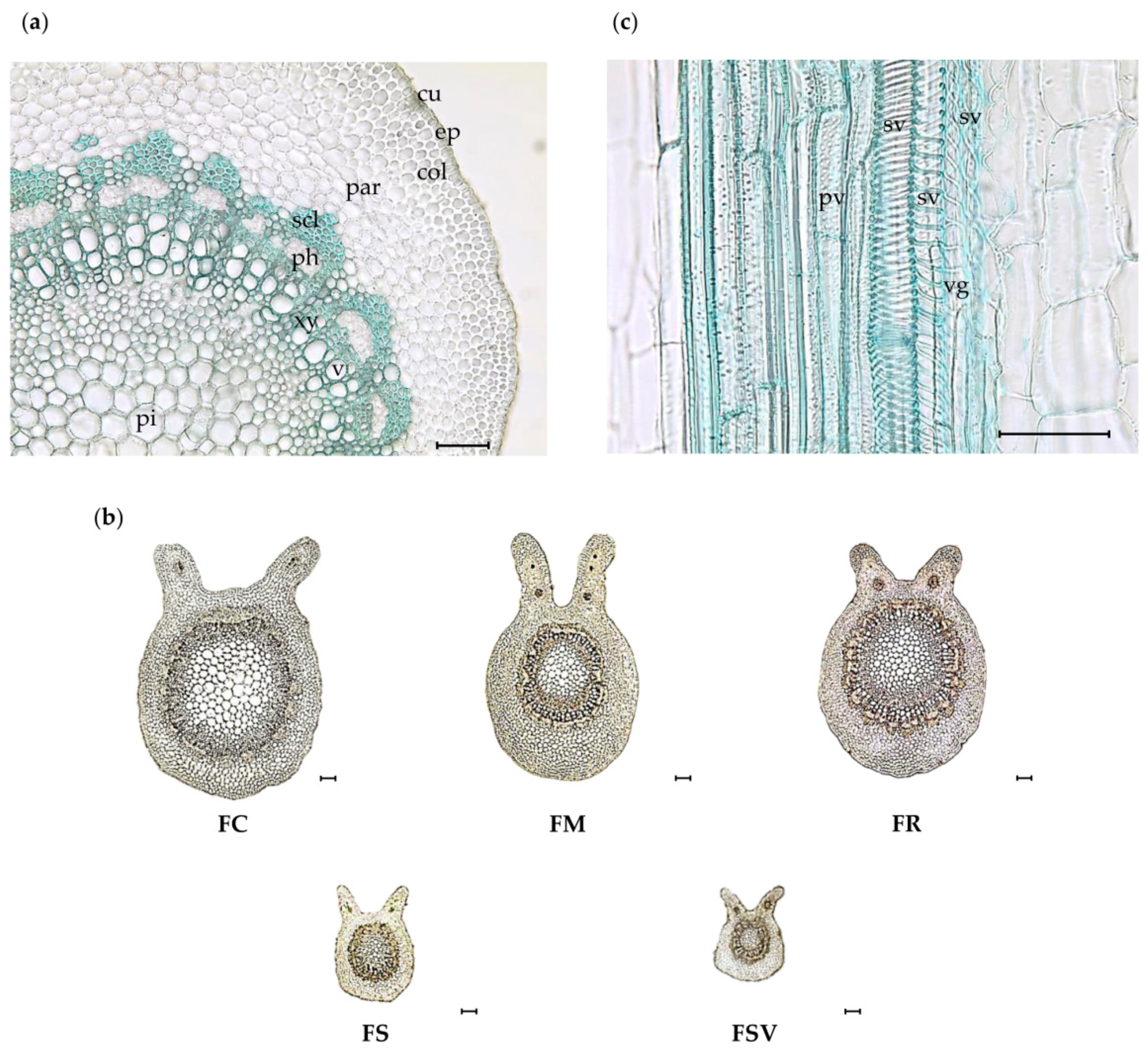
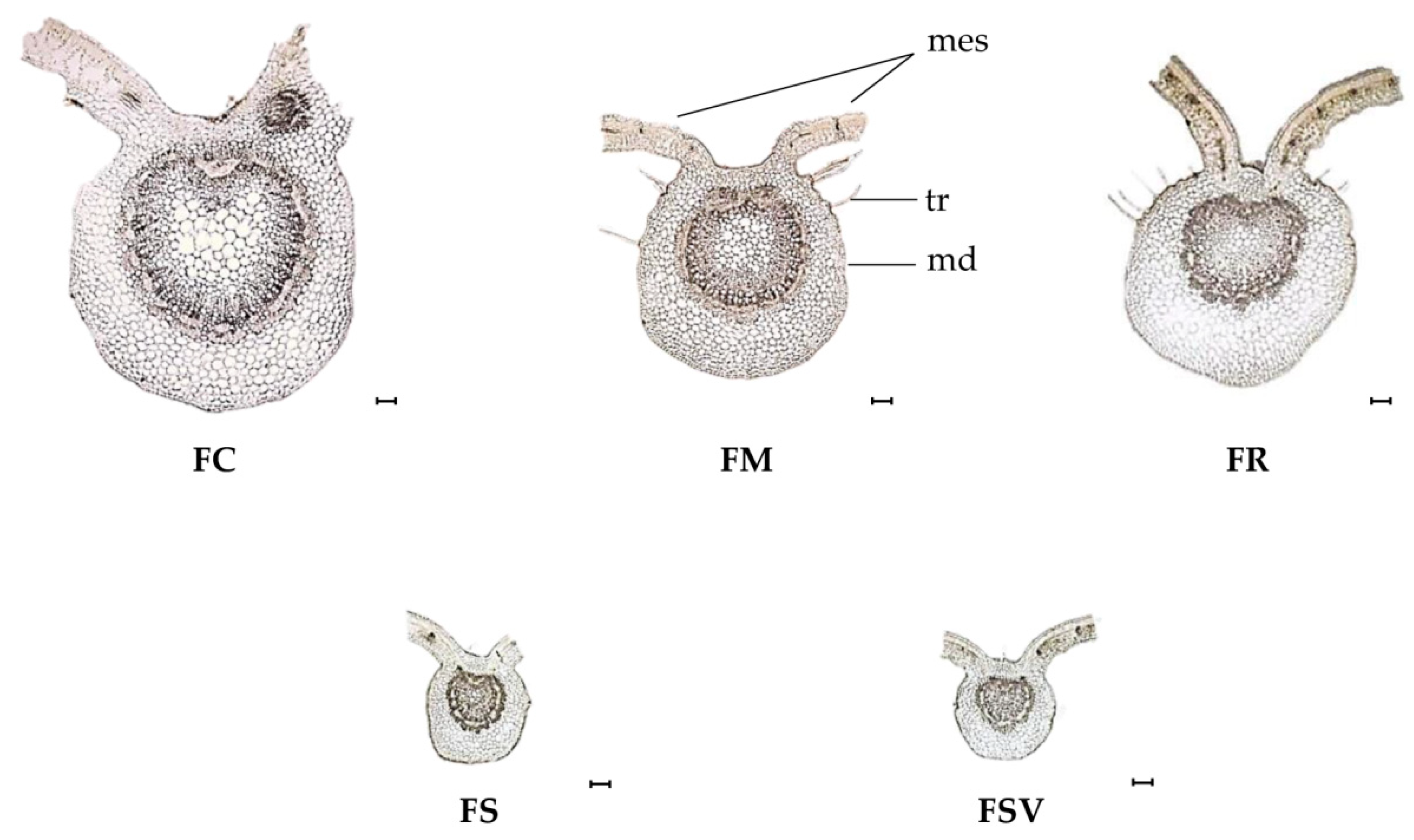
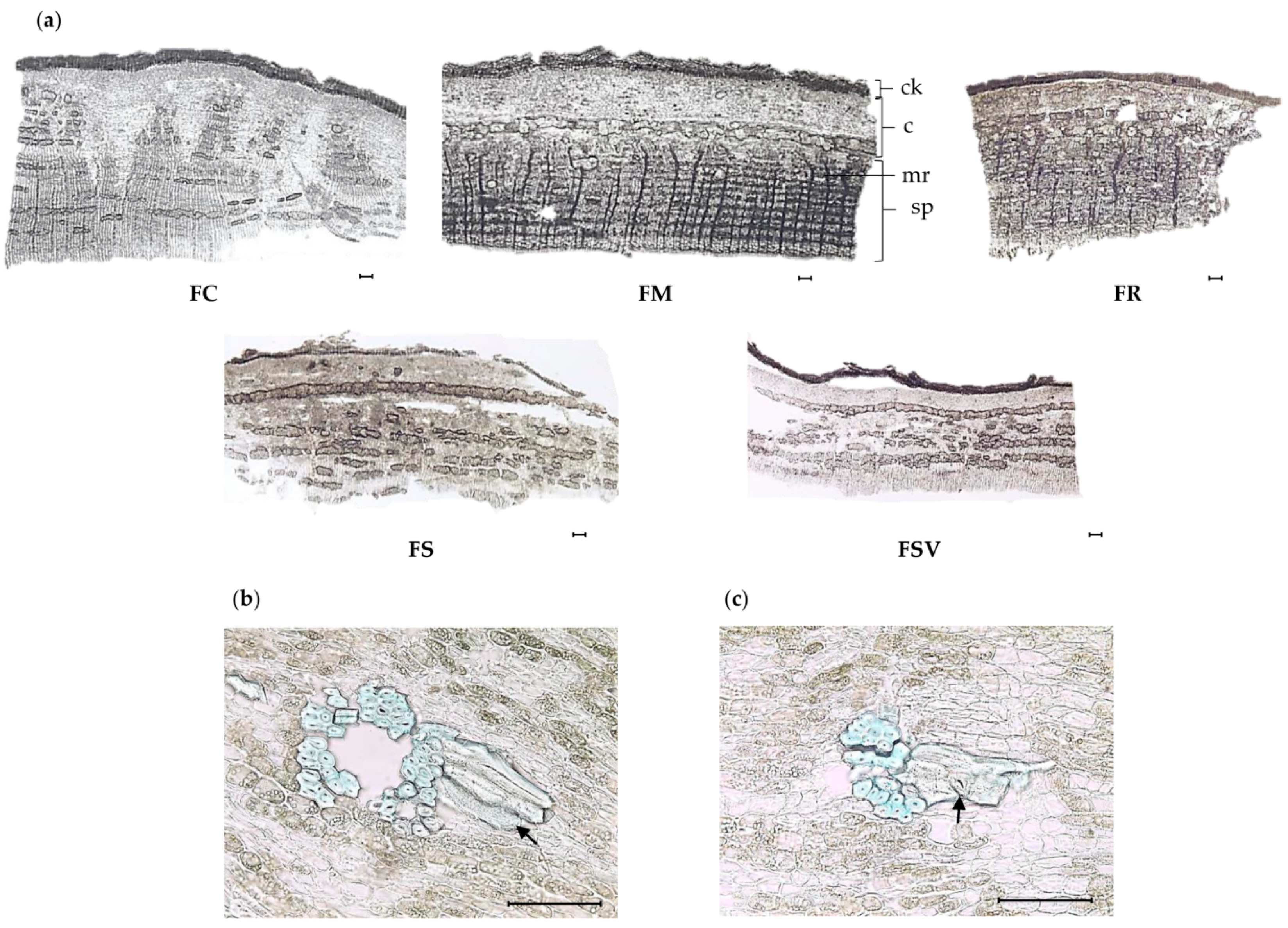
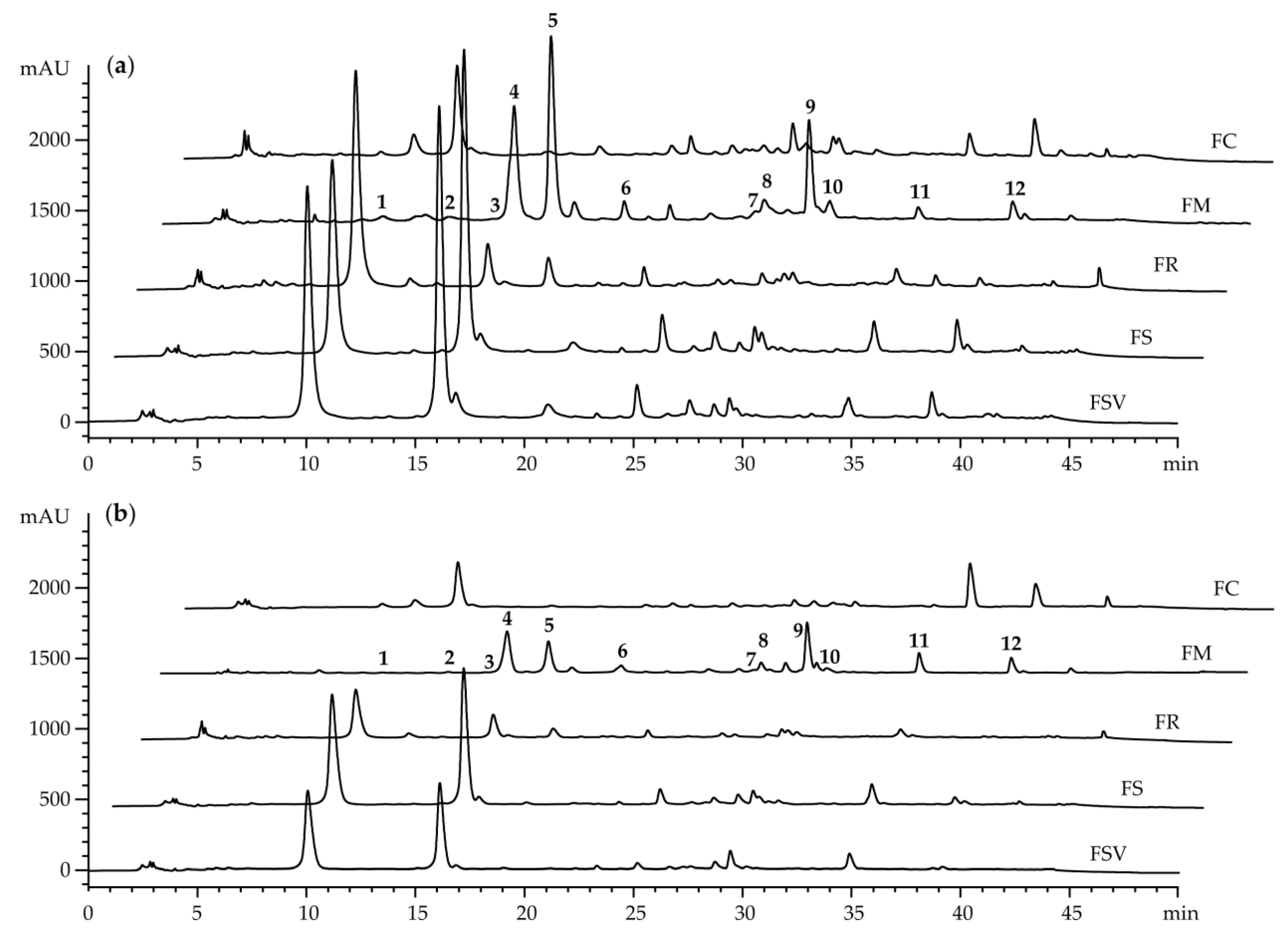
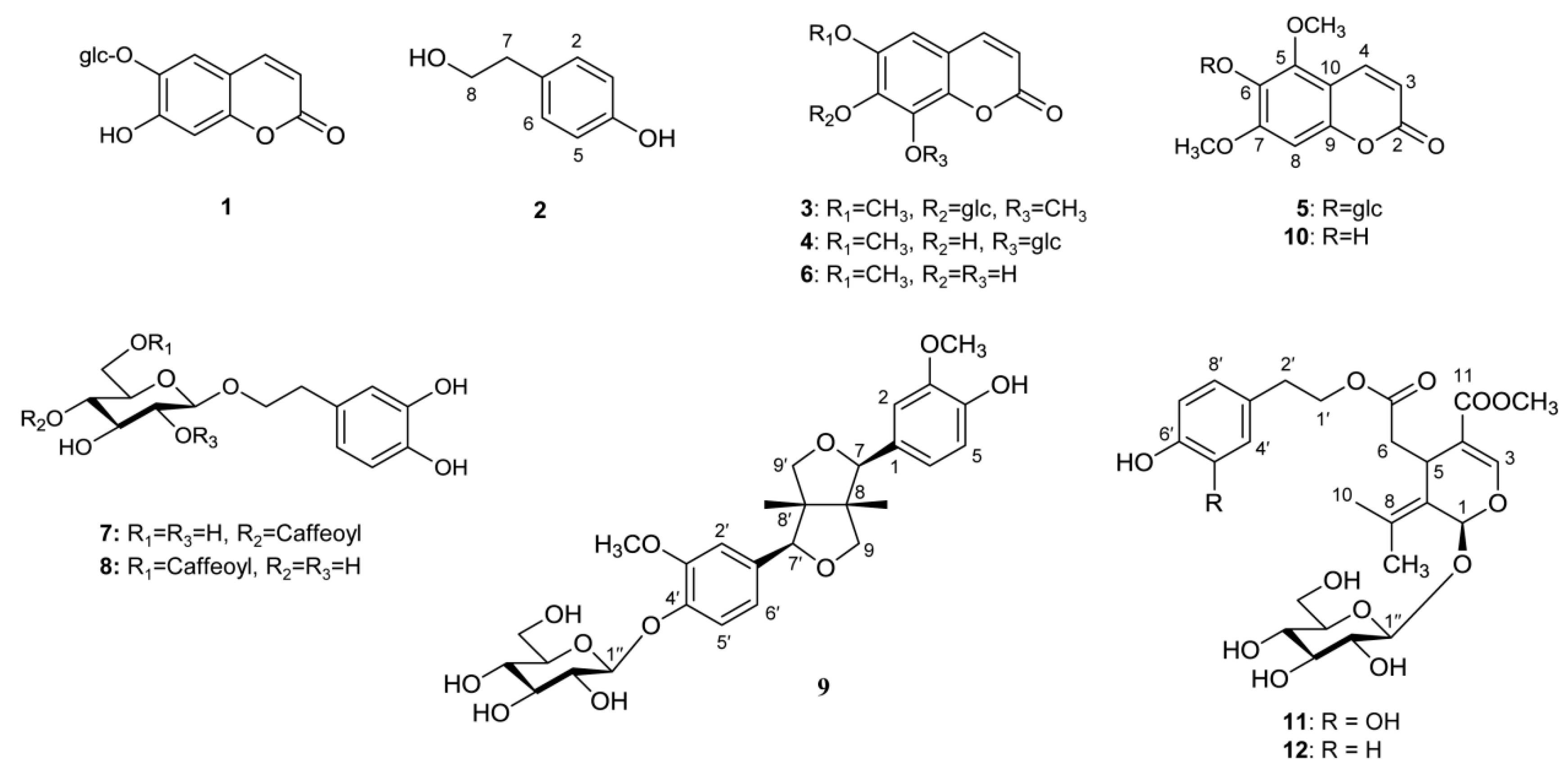
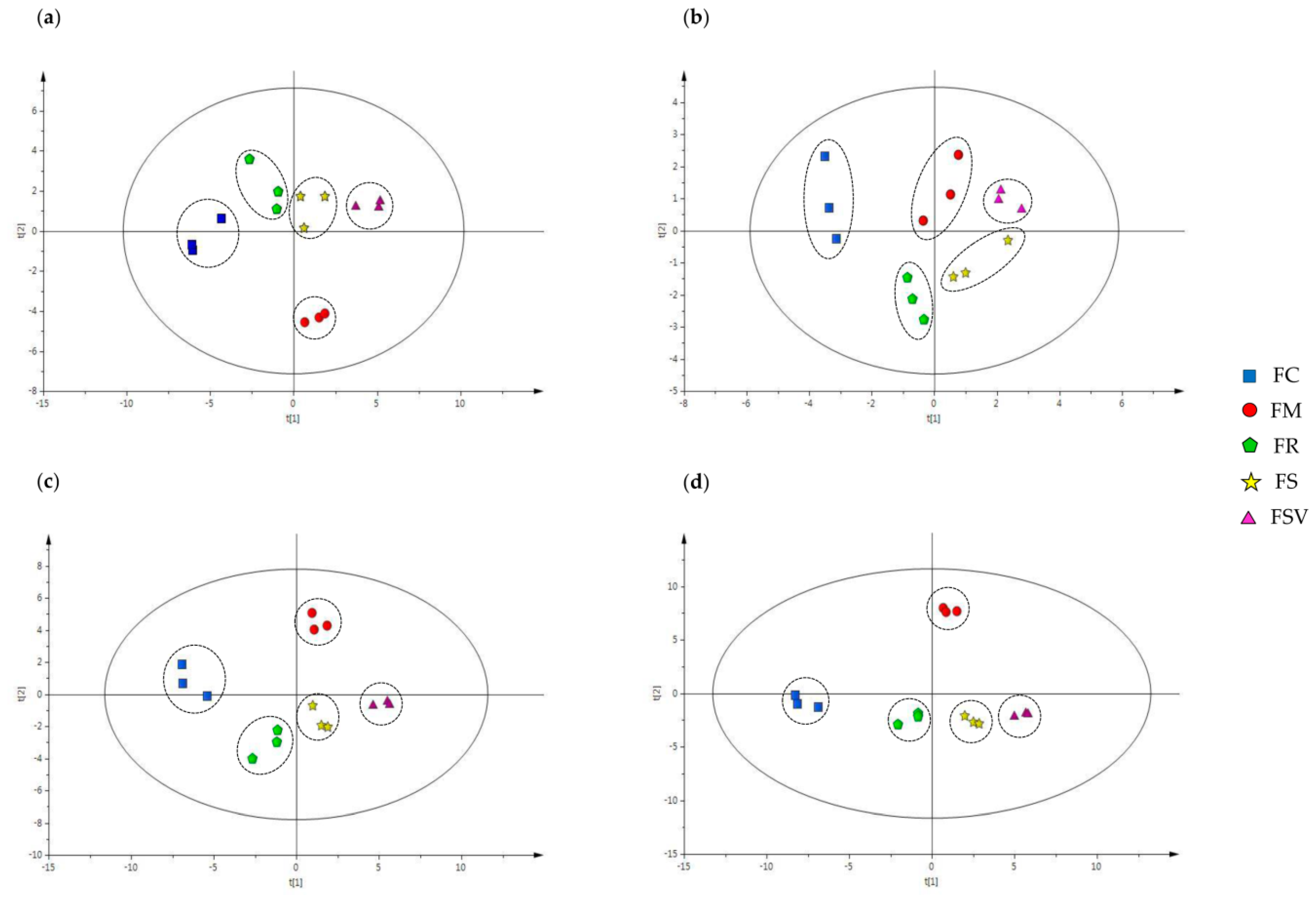
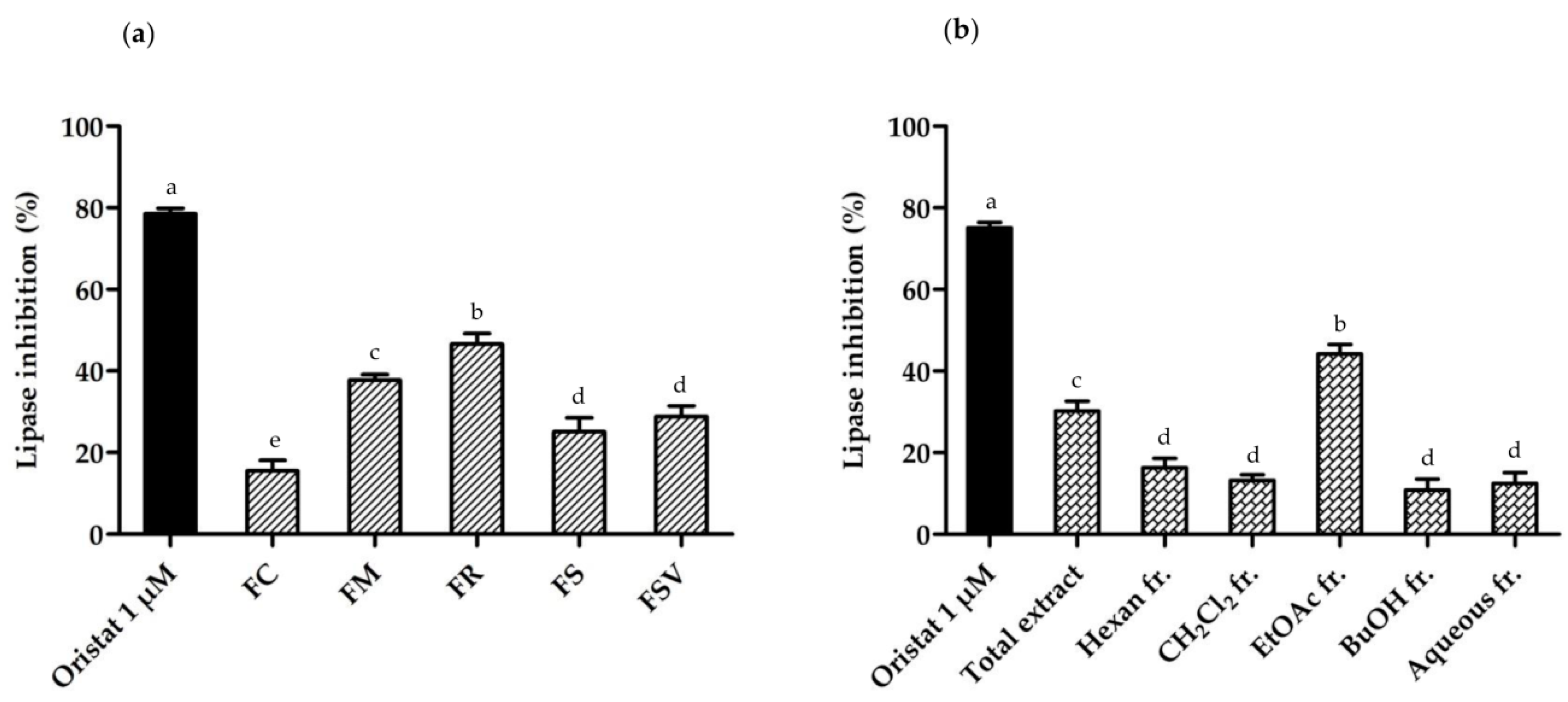
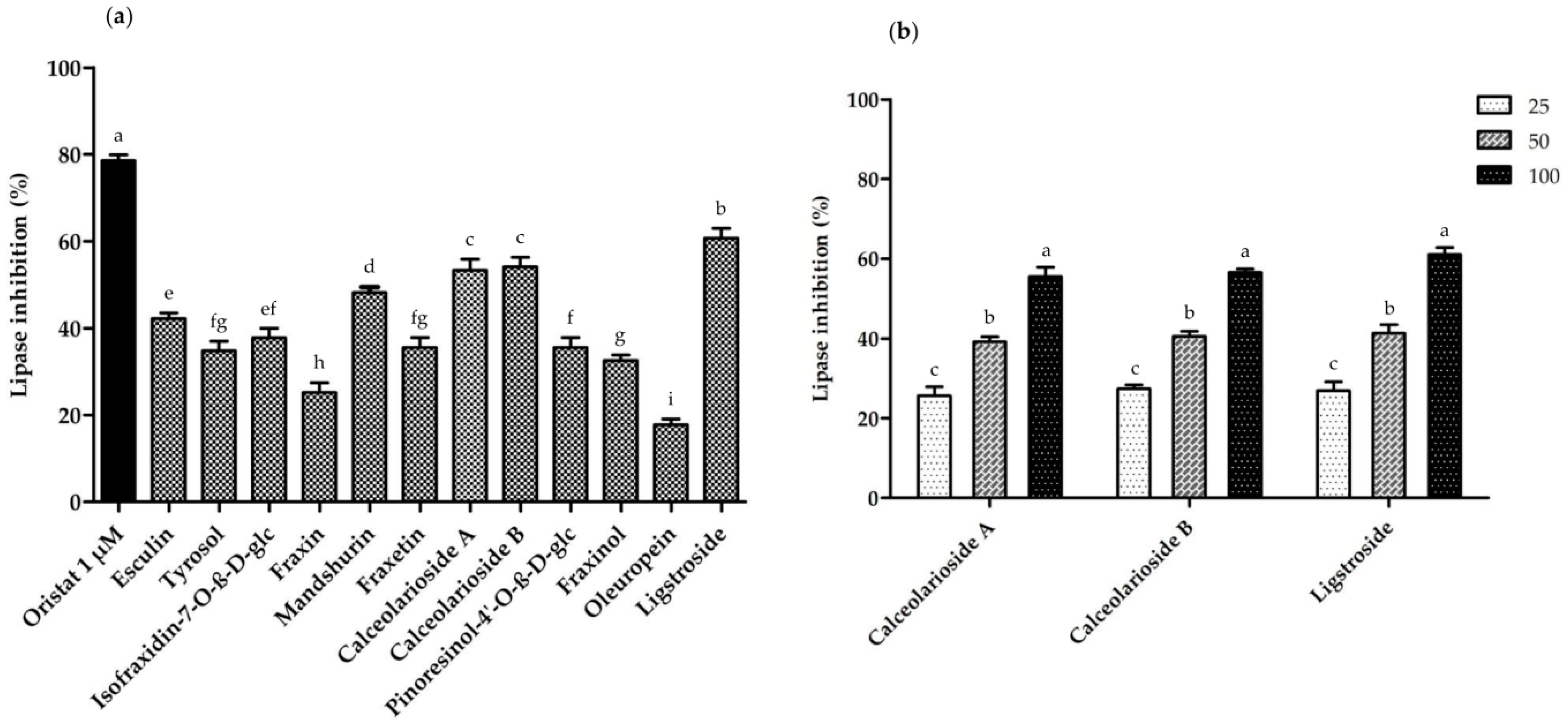
| Parameters | FC | FM | FR | FS | FSV |
|---|---|---|---|---|---|
| Number of glandular trichome (in 500 × 500 μm2) | 1.7 ± 0.2c | 2.4 ± 0.4b | 2.5 ± 0.4b | 3.6 ± 0.9b | 7.0 ± 0.4a |
| Diameter of glandular trichome (μm) | 41.1 ± 1.9a | 42.8 ± 3.7a | 36.3 ± 0.8b | 42.3 ± 2.8a | 32.3 ± 1.5c |
| Number of epidermal cells (in 300 × 300 μm2) | 78.4 ± 11.3c | 148.4 ± 12.5a | 98.5 ± 14.2c | 92.3 ± 4.8c | 122.8 ± 8.2b |
| Number of stomata (in 300 × 300 μm2) | 11.7 ± 0.4e | 33.9 ± 4.0a | 19.3 ± 1.8c | 14.7 ± 1.3d | 24.6 ± 3.0b |
| Stomatal length (μm) | 37.5 ± 2.0a | 22.8 ± 0.6c | 33.4 ± 0.7b | 34.7 ± 2.3ab | 32.5 ± 1.6b |
| Stomatal width (μm) | 26.0 ± 2.4a | 17.1 ± 0.5b | 23.9 ± 1.5a | 24.2 ± 2.5a | 25.0 ± 1.5a |
| Stomatal index | 13.0 ± 1.1b | 18.7 ± 1.5a | 16.4 ± 1.8a | 13.7 ± 1.3b | 16.7 ± 0.9a |
| Parameters | FC | FM | FR | FS | FSV |
|---|---|---|---|---|---|
| Size of epidermal cell of adaxial portion (length × width, μm) | 17.4 ± 1.3a × 17.8 ± 1a | 11.2 ± 1c × 11.8 ± 1b | 19.4 ± 2.3a × 15.6 ± 1.7ab | 13.8 ± 1.3b × 12.4 ± 2.2b | 12.9 ± 1b × 11.6 ± 0.9b |
| Size of epidermal cell of abaxial portion (length × width, μm) | 13.3 ± 1.4b × 13.6 ± 1.6b | 10.2 ± 1.0c × 11.5 ± 1b | 21.1 ± 2.3a × 18.7 ± 3.5a | 17.5 ± 1.9a × 14.9 ± 1.0ab | 13.6 ± 0.9b × 12.4 ± 0.8b |
| Ratio of cortex thickness to radius in abaxial portion | 0.23 ± 0.03b | 0.29 ± 0.01a | 0.30 ± 0.04a | 0.28 ± 0.02a | 0.27 ± 0.01a |
| Diameter of parenchyma cell of cortex in adaxial portion (μm) | 35.3 ± 2.5a | 24.8 ± 1.9b | 24.9 ± 2.0b | 24.7 ± 1.5b | 20.0 ± 0.4c |
| Diameter of parenchyma cell in abaxial portion (μm) | 51.6 ± 4.6a | 42.5 ± 1.8b | 40.4 ± 2.7b | 33.4 ± 2.0c | 27.7 ± 1.2d |
| Number of sclerenchyma cell (in 300 × 300 μm2) | 40.9 ± 5.3d | 51.3 ± 3.2c | 70.5 ± 4.7b | 54.9 ± 3.0c | 80.3 ± 3.4a |
| Diameter of parenchyma cell in pith (μm) | 81.3 ± 2.6a | 54.3 ± 3.0b | 54.5 ± 10.9b | 37.7 ± 2.7c | 30.9 ± 2.3d |
| Parameters | FC | FM | FR | FS | FSV |
|---|---|---|---|---|---|
| Size of epidermal cell of adaxial portion (length × width, μm) | 21.8 ± 1.5a × 19.1 ± 1.6a | 17.0 ± 2.5b × 14.9 ± 0.3b | 21.8 ± 4.0ab × 16.6 ± 2.1ab | 15.0 ± 1.1b × 13.5 ± 1.6b | 13.1 ± 0.4c × 11.9 ± 0.9b |
| Size of epidermal cell of abaxial portion (length × width, μm) | 13.6 ± 1.1ab × 14.3 ± 1.0b | 11.3 ± 1.8b × 13.6 ± 1.4b | 16.3 ± 2.0a × 18.8 ± 2.4a | 13.1 ± 1.0b × 15.1 ± 2.2ab | 12.4 ± 0.6b × 13.2 ± 0.5b |
| Number of sclerenchyma cell (in 300 × 300 μm2) | 38.6 ± 3.0c | 52.7 ± 9.2b | 70.1 ± 6.5b | 75.5 ± 17.1b | 114.8 ± 18.7a |
| Diameter of parenchyma cell in adaxial portion (μm) | 28.4 ± 1.9a | 23.8 ± 1.4ab | 29.9 ± 5.4a | 20.7 ± 2.3b | 18.1 ± 0.8b |
| Diameter of parenchyma cell in abaxial portion (μm) | 53.4 ± 2.5a | 43.8 ± 1.2b | 45.2 ± 2.4b | 35.0 ± 2.7c | 29.2 ± 0.7d |
| Diameter of parenchyma cell in pith (μm) | 75.7 ± 3.7a | 61.4 ± 4.4b | 49.2 ± 4.1c | 28.4 ± 4.0d | 22.2 ± 3.5d |
| Size of palisade cell (length × width, μm) | 48.6 ± 4.6a × 17.4 ± 4.7a | 44.3 ± 4.5ab × 12.5 ± 0.4a | 44.4 ± 6.4ab × 14.2 ± 0.7a | 46.2 ± 3.0a × 14.4 ± 1.5a | 40.8 ± 1.8b × 12.5 ± 0.5a |
| Palisade ratio | 1.7 ± 0.1b | 2.0 ± 0.2a | 1.9 ± 0.2ab | 2.1 ± 0.2a | 2.2 ± 0.2a |
| Parameters | FC | FM | FR | FS | FSV |
|---|---|---|---|---|---|
| Size of cork cell (length × width, μm) | 21.2 ± 3.4ab × 53.6 ± 4.9a | 20.1 ± 4.8ab × 40.0 ± 3.6b | 13.6 ± 1.3b × 33.1 ± 2.3c | 16.2 ± 0.9b × 36.8 ± 1.8bc | 22.1 ± 1.1a × 36.2 ± 1.6bc |
| Diameter of parenchyma cell (in cortex length × width, μm) | 28.1 ± 2.0a × 55.3 ± 2.2a | 24.8 ± 1.4ab × 44.5 ± 1.9b | 24.5 ± 2.7ab × 51.6 ± 1.5a | 23.0 ± 1.2b × 42.9 ± 2.5b | 22.8 ± 0.7b × 40.6 ± 1.7b |
| Number of phloem fiber (in 500 × 500 μm2) | 83.7 ± 4.6c | 85.4 ± 3.2c | 123.0 ± 16.5ab | 138.4 ± 3.5a | 122.7 ± 4.2b |
| Number of phloem ray (in 500 × 500 μm2) | 3.4 ± 0.3b | 4.5 ± 0.5ab | 3.3 ± 0.2b | 3.6 ± 0.5b | 4.8 ± 0.2a |
| Size of phloem ray (length × width, μm) | 40.5 ± 0.3a × 21.1 ± 2.0a | 34.8 ± 0.8b × 15.0 ± 1.5b | 34.5 ± 4.3ab × 20.9 ± 1.2a | 32.1 ± 4.5b × 15.5 ± 2.1b | 28.3 ± 0.4b × 14.7 ± 0.4b |
| Compounds | Season | FC | FM | FR | FS | FSV |
|---|---|---|---|---|---|---|
| Esculin (1) | Summer | ND* | 0.31 ± 0.04c | 32.5 ± 2.4b | 31.6 ± 2.5b | 38.7 ± 3.1a |
| Autumn | ND | 0.24 ± 0.09c | 24.8 ± 0.8a | 28.8 ± 4.8a | 20.8 ± 2.5b | |
| Tyrosol (2) | Summer | ND | 0.56 ± 0.11a | ND | ND | ND |
| Autumn | ND | 0.48 ± 0.09a | ND | ND | ND | |
| Isofraxidin-7-O-β-D-glucopyranoside (3) | Summer | ND | 2.39 ± 0.41a | 0.23 ± 0.04b | ND | ND |
| Autumn | ND | 1.66 ± 0.14a | 0.22 ± 0.01b | ND | ND | |
| Fraxin (4) | Summer | ND | 14.8 ± 2.2b | 10.8 ± 1.4c | 58.1 ± 3.9a | 61.7 ± 3.9a |
| Autumn | ND | 8.32 ± 1.61c | ND | 37.0 ± 2.4a | 24.8 ± 3.0b | |
| Mandshurin (5) | Summer | ND | 20.6 ± 0.7a | ND | ND | ND |
| Autumn | ND | 10.2 ± 0.5a | ND | ND | ND | |
| Fraxetin (6) | Summer | ND | 0.27 ± 0.03b | 0.08 ± 0.00c | 1.39 ± 0.12a | 1.53 ± 0.15a |
| Autumn | ND | 0.26 ± 0.01a | ND | ND | ND | |
| Calceolarioside A (7) | Summer | 10.9 ± 1.0b | 4.26 ± 1.50c | 2.23 ± 0.42d | 13.5 ± 1.2a | 10.7 ± 0.4b |
| Autumn | 7.44 ± 1.23a | 1.96 ± 0.27c | ND | 7.69 ± 1.42a | 2.72 ± 0.53b | |
| Calceolarioside B (8) | Summer | ND | 30.4 ± 2.9a | 10.3 ± 0.7b | 10.6 ± 1.0b | 9.11 ± 1.32b |
| Autumn | ND | 9.94 ± 1.45a | 4.04 ± 0.27b | 8.90 ± 1.74a | 7.91 ± 1.13a | |
| Pinoresinol-4′-O-β-D-glucopyranoside (9) | Summer | ND | 12.1 ± 0.4a | 0.62 ± 0.17d | 1.74 ± 0.06b | 0.82 ± 0.05c |
| Autumn | ND | 9.74 ± 0.56a | 0.61 ± 0.06c | 0.77 ± 0.04b | 0.24 ± 0.00d | |
| Fraxinol (10) | Summer | ND | 0.53 ± 0.05a | ND | ND | ND |
| Autumn | ND | 0.47 ± 0.02a | ND | ND | ND | |
| Oleuropein (11) | Summer | ND | 16.9 ± 0.4a | 10.2 ± 2.0b | 5.34 ± 0.99d | 6.77 ± 0.25c |
| Autumn | ND | 6.98 ± 0.32a | 5.10 ± 0.97b | 2.97 ± 0.59c | 6.26 ± 0.95ab | |
| Ligstroside (12) | Summer | 27.9 ± 1.8a | 15.5 ± 0.9b | 2.11 ± 0.41c | 2.74 ± 0.47c | 1.97 ± 0.22cd |
| Autumn | 23.9 ± 0.8a | 14.7 ± 0.7b | ND | 2.51 ± 0.50c | 1.80 ± 0.31c | |
| Total coumarins | Summer | ND | 38.9 ± 3.4c | 43.6 ± 3.8c | 91.1 ± 6.5b | 101.9 ± 7.2a |
| Autumn | ND | 21.2 ± 2.3d | 25.5 ± 0.8c | 65.8 ± 7.2a | 45.5 ± 5.5b | |
| Total phenylethanoids | Summer | 10.9 ± 1.0d | 35.3 ± 4.5a | 12.5 ± 1.1d | 24.1 ± 2.2b | 19.8 ± 1.7c |
| Autumn | 7.44 ± 1.23c | 12.4 ± 1.7b | 4.04 ± 0.27d | 16.6 ± 3.2a | 10.6 ± 1.7bc | |
| Total secoiridoids | Summer | 27.9 ± 1.8b | 32.4 ± 1.3a | 12.3 ± 2.4c | 8.08 ± 1.46d | 8.74 ± 0.47d |
| Autumn | 23.9 ± 0.8a | 21.7 ± 1.0b | 5.08 ± 0.97d | 5.48 ± 1.09d | 8.06 ± 1.26c | |
| Total | Summer | 38.8 ± 2.8c | 118.6 ± 9.6a | 69.1 ± 7.5b | 125.0 ± 10.2a | 131.3 ± 9.4a |
| Autumn | 31.3 ± 2.0c | 65.0 ± 5.7b | 34.8 ± 2.1c | 88.6 ± 11.5a | 64.5 ± 8.4b |
| Botanical Name | Collection Places (Latitude, Longitude) | Collection Year | Specimen No. | Abbreviations |
|---|---|---|---|---|
| Fraxinus chiisanensis Nakai | Sancheong (35°27′55.9″N, 127°56′06.7″E) (35°27′55.4″N, 127°56′07.9″E) Jiri Mt. (35°14′58.8″N, 127°42′31.2″E) (35°14′58.0″N, 127°42′29.8″E) Pocheon (37°45′07.1″N, 127°09′58.7″E) | 2016–2018 | PGSC-560-1~7 | FC |
| F. mandshurica Rupr. | Sancheong (35°14′00.1″N, 127°47′53.9″E) Jinju (35°10′53.3″N, 128°05′42.8″E) (35°13′59.9″N, 127°47′54.1″E) Pocheon (37°44′57.2″N, 127°09′55.7″E) | 2016–2018 | PGSC-561-1~12 | FM |
| F. rhynchophylla Hance | Jinju (35°10′53.1″N, 128°05′42.6″E) Jiri Mt. (35°15′02.1″N, 127°42′30.1″E) Youngwol (37°12′18.4″N, 128°26′05.3″E) Pocheon (37°45′10.2″N, 127°09′49.6″E) | 2016–2018 | PGSC-562-1~20 | FR |
| F. sieboldiana Blume | Jiri Mt. (35°14′54.5″N, 127°42′18.3″E) Miryang (35°34′06.6″N, 128°59′34.4″E) (35°34′04.7″N, 128°59′34.9″E) Pocheon (37°45′11.9″N, 127°09′54.9″E) | 2016–2019 | PGSC-563-1~15 | FS |
| F. sieboldiana var. angustata Blume | Jiri Mt. (35°14′53.7″N, 127°42′30.0″E) Miryang (35°34′05.2″N, 128°59′34.4″E) (35°34′05.7″N, 128°59′31.8″E) Sancheong (35°17′46.8″N, 127°58′29.6″E) Pocheon (37°45′11.4″N, 127°09′56.2″E) | 2016–2019 | PGSC-564-1~15 | FSV |
© 2020 by the authors. Licensee MDPI, Basel, Switzerland. This article is an open access article distributed under the terms and conditions of the Creative Commons Attribution (CC BY) license (http://creativecommons.org/licenses/by/4.0/).
Share and Cite
Akter, K.-M.; Park, W.S.; Kim, H.-J.; Khalil, A.A.K.; Ahn, M.-J. Comparative Studies of Fraxinus Species from Korea Using Microscopic Characterization, Phytochemical Analysis, and Anti-Lipase Enzyme Activity. Plants 2020, 9, 534. https://doi.org/10.3390/plants9040534
Akter K-M, Park WS, Kim H-J, Khalil AAK, Ahn M-J. Comparative Studies of Fraxinus Species from Korea Using Microscopic Characterization, Phytochemical Analysis, and Anti-Lipase Enzyme Activity. Plants. 2020; 9(4):534. https://doi.org/10.3390/plants9040534
Chicago/Turabian StyleAkter, Kazi-Marjahan, Woo Sung Park, Hye-Jin Kim, Atif Ali Khan Khalil, and Mi-Jeong Ahn. 2020. "Comparative Studies of Fraxinus Species from Korea Using Microscopic Characterization, Phytochemical Analysis, and Anti-Lipase Enzyme Activity" Plants 9, no. 4: 534. https://doi.org/10.3390/plants9040534
APA StyleAkter, K.-M., Park, W. S., Kim, H.-J., Khalil, A. A. K., & Ahn, M.-J. (2020). Comparative Studies of Fraxinus Species from Korea Using Microscopic Characterization, Phytochemical Analysis, and Anti-Lipase Enzyme Activity. Plants, 9(4), 534. https://doi.org/10.3390/plants9040534





